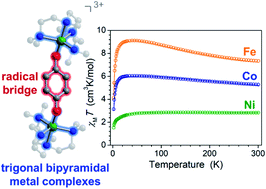Semiquinone radical-bridged M2 (M = Fe, Co, Ni) complexes with strong magnetic exchange giving rise to slow magnetic relaxation†
Abstract
The use of radical bridging ligands to facilitate strong magnetic exchange between paramagnetic metal centers represents a key step toward the realization of single-molecule magnets with high operating temperatures. Moreover, bridging ligands that allow the incorporation of high-anisotropy metal ions are particularly advantageous. Toward these ends, we report the synthesis and detailed characterization of the dinuclear hydroquinone-bridged complexes [(Me6tren)2MII2(C6H4O22−)]2+ (Me6tren = tris(2-dimethylaminoethyl)amine; M = Fe, Co, Ni) and their one-electron-oxidized, semiquinone-bridged analogues [(Me6tren)2MII2(C6H4O2−˙)]3+. Single-crystal X-ray diffraction shows that the Me6tren ligand restrains the metal centers in a trigonal bipyramidal geometry, and coordination of the bridging hydro- or semiquinone ligand results in a parallel alignment of the three-fold axes. We quantify the p-benzosemiquinone–transition metal magnetic exchange coupling for the first time and find that the nickel(II) complex exhibits a substantial J < −600 cm−1, resulting in a well-isolated S = 3/2 ground state even as high as 300 K. The iron and cobalt complexes feature metal–semiquinone exchange constants of J = −144(1) and −252(2) cm−1, respectively, which are substantially larger in magnitude than those reported for related bis(bidentate) semiquinoid complexes. Finally, the semiquinone-bridged cobalt and nickel complexes exhibit field-induced slow magnetic relaxation, with relaxation barriers of Ueff = 22 and 46 cm−1, respectively. Remarkably, the Orbach relaxation observed for the Ni complex is in stark contrast to the fast processes that dominate relaxation in related mononuclear NiII complexes, thus demonstrating that strong magnetic coupling can engender slow magnetic relaxation.



 Please wait while we load your content...
Please wait while we load your content...